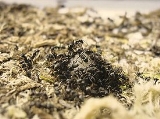
Formica fusca
Encyclopedia
Formica fusca, the common black ant
of Europe
, is a palaearctic ant with a range extending from Portugal
in the west to Japan
in the east and from Italy
in the south to Fennoscandia
in the north. F. fusca nests are usually found in rotten tree stumps or under stones in clearcut areas and along woodland borders and hedgerows.
Colonies are facultatively polygynous
(though weakly so); though the queens coexist amicably, contribution to the brood tends to be unequal. Nests are usually small, containing 500–2,000 workers. The workers are large, at 8–10 mm (0.31496062992126–0.393700787401575 ) long, and fast moving, though timid. F. fusca feeds on small insects, aphid
honeydew and extra floral nectaries. Alate (winged) forms are produced in June/July and nuptial flight
s are in July/August.
Workers have been found to have a very high resistance to some pathogens and its thought this may be due to F.fusca utilising the antibiotic properties of their formic acid, additional to the use of their metapleural gland
.
A recent study has found evidence of nepotism
in F. fusca, in contrast with previous experiments with other ant species; this conclusion has been challenged, however, on the grounds that the observed pattern may result from differences in egg viability.
Ant
Ants are social insects of the family Formicidae and, along with the related wasps and bees, belong to the order Hymenoptera. Ants evolved from wasp-like ancestors in the mid-Cretaceous period between 110 and 130 million years ago and diversified after the rise of flowering plants. More than...
of Europe
Europe
Europe is, by convention, one of the world's seven continents. Comprising the westernmost peninsula of Eurasia, Europe is generally 'divided' from Asia to its east by the watershed divides of the Ural and Caucasus Mountains, the Ural River, the Caspian and Black Seas, and the waterways connecting...
, is a palaearctic ant with a range extending from Portugal
Portugal
Portugal , officially the Portuguese Republic is a country situated in southwestern Europe on the Iberian Peninsula. Portugal is the westernmost country of Europe, and is bordered by the Atlantic Ocean to the West and South and by Spain to the North and East. The Atlantic archipelagos of the...
in the west to Japan
Japan
Japan is an island nation in East Asia. Located in the Pacific Ocean, it lies to the east of the Sea of Japan, China, North Korea, South Korea and Russia, stretching from the Sea of Okhotsk in the north to the East China Sea and Taiwan in the south...
in the east and from Italy
Italy
Italy , officially the Italian Republic languages]] under the European Charter for Regional or Minority Languages. In each of these, Italy's official name is as follows:;;;;;;;;), is a unitary parliamentary republic in South-Central Europe. To the north it borders France, Switzerland, Austria and...
in the south to Fennoscandia
Fennoscandia
Fennoscandia and Fenno-Scandinavia are geographic and geological terms used to describe the Scandinavian Peninsula, the Kola Peninsula, Karelia and Finland...
in the north. F. fusca nests are usually found in rotten tree stumps or under stones in clearcut areas and along woodland borders and hedgerows.
Colonies are facultatively polygynous
Polygyny
Polygyny is a form of marriage in which a man has two or more wives at the same time. In countries where the practice is illegal, the man is referred to as a bigamist or a polygamist...
(though weakly so); though the queens coexist amicably, contribution to the brood tends to be unequal. Nests are usually small, containing 500–2,000 workers. The workers are large, at 8–10 mm (0.31496062992126–0.393700787401575 ) long, and fast moving, though timid. F. fusca feeds on small insects, aphid
Aphid
Aphids, also known as plant lice and in Britain and the Commonwealth as greenflies, blackflies or whiteflies, are small sap sucking insects, and members of the superfamily Aphidoidea. Aphids are among the most destructive insect pests on cultivated plants in temperate regions...
honeydew and extra floral nectaries. Alate (winged) forms are produced in June/July and nuptial flight
Nuptial flight
Nuptial flight is an important phase in the reproduction of most ant, termite and some bee species. During the flight, virgin queens mate with males and then land to start a new colony, or, in the case of honey bees, continue the planned succession of an existing hived colony.- Before the flight :A...
s are in July/August.
Workers have been found to have a very high resistance to some pathogens and its thought this may be due to F.fusca utilising the antibiotic properties of their formic acid, additional to the use of their metapleural gland
Metapleural gland
Metapleural glands are secretory glands that are unique to ants and basal in the evolutionary history of ants. They are responsible for the production of an antibiotic fluid that then collects in in a reservoir on the posterior of the ant's alitrunk...
.
A recent study has found evidence of nepotism
Nepotism
Nepotism is favoritism granted to relatives regardless of merit. The word nepotism is from the Latin word nepos, nepotis , from which modern Romanian nepot and Italian nipote, "nephew" or "grandchild" are also descended....
in F. fusca, in contrast with previous experiments with other ant species; this conclusion has been challenged, however, on the grounds that the observed pattern may result from differences in egg viability.

